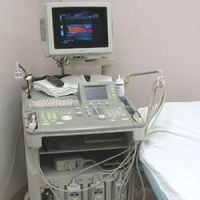Using PET/CT with whole-body MRI (WBMRI) is effective in detecting extraskeletal disease, according to Stanford University researchers who suggest that this technique may change the management of high-risk breast and prostate cancer patients. The researchers also found that the combined administration of F-18 sodium fluoride (NaF) and F-18 fluorodeoxyglucose (FDG) in a single PET/CT scan shows significantly higher sensitivity and accuracy than alternative methods for the detection of skeletal lesions.
"Using results from previous studies, this project attempts to identify the most appropriate approach for identifying lesions in selected breast and prostate cancer patients who are at high risk of developing metastatic disease," says Andrei H. Iagaru, MD, FACNM, corresponding author of this Stanford University study published in The Journal of Nuclear Medicine.
In the study, Dr. Iagaru and colleagues compared results of the combined use of F-18 NaF/F-18 FDG PET/CT in patients with breast or prostate cancers with those obtained using Tc-99m MDP bone scintigraphy and WBMRI. Thirty patients (15 women with breast cancer and 15 men with prostate cancer) referred for standard-of-care bone scintigraphy were prospectively enrolled in the study. NaF/FDG PET/CT and WBMRI were performed following bone scintigraphy.
Results showed that NaF/FDG PET/CT is significantly more accurate in detecting skeletal lesions than WBMRI and Tc-99m MDP scintigraphy. In addition, NaF/FDG PET/CT and WBMRI detected extraskeletal disease that may change the way treatment is managed for these patients.
"The combined administration of NaF/FDG in a single PET/CT scan provides appropriate staging of high-risk patients with prostate (higher than stage II or PSA higher than 10) or breast (higher than stage III) cancers," Dr. Iagaru notes, "but WBMRI may be beneficial, particularly for brain and liver metastases detection."
He says that bone scintigraphy will continue to be used as the initial tool for skeletal metastases detection due to low cost and high performance. However, evaluation of patients with negative/equivocal bone scans and high clinical suspicion for metastases will be done using combined modalities that may simplify the diagnostic algorithm for referring physicians and patients, the doctor points out.
Dr. Iagaru considers molecular imaging and nuclear medicine techniques to be at the forefront of advancing patient care. Looking ahead, he notes, "More work remains to be done, and our group is now exploring the use of combined NaF/FDG injections with state of the art PET/MRI technology for significant decreases in radiation exposure and improved diagnostic performance in accurately evaluating extent of disease in cancer patients."
Source: Society of Nuclear Medicine
Image credit: Wikimedia Commons
"Using results from previous studies, this project attempts to identify the most appropriate approach for identifying lesions in selected breast and prostate cancer patients who are at high risk of developing metastatic disease," says Andrei H. Iagaru, MD, FACNM, corresponding author of this Stanford University study published in The Journal of Nuclear Medicine.
In the study, Dr. Iagaru and colleagues compared results of the combined use of F-18 NaF/F-18 FDG PET/CT in patients with breast or prostate cancers with those obtained using Tc-99m MDP bone scintigraphy and WBMRI. Thirty patients (15 women with breast cancer and 15 men with prostate cancer) referred for standard-of-care bone scintigraphy were prospectively enrolled in the study. NaF/FDG PET/CT and WBMRI were performed following bone scintigraphy.
Results showed that NaF/FDG PET/CT is significantly more accurate in detecting skeletal lesions than WBMRI and Tc-99m MDP scintigraphy. In addition, NaF/FDG PET/CT and WBMRI detected extraskeletal disease that may change the way treatment is managed for these patients.
"The combined administration of NaF/FDG in a single PET/CT scan provides appropriate staging of high-risk patients with prostate (higher than stage II or PSA higher than 10) or breast (higher than stage III) cancers," Dr. Iagaru notes, "but WBMRI may be beneficial, particularly for brain and liver metastases detection."
He says that bone scintigraphy will continue to be used as the initial tool for skeletal metastases detection due to low cost and high performance. However, evaluation of patients with negative/equivocal bone scans and high clinical suspicion for metastases will be done using combined modalities that may simplify the diagnostic algorithm for referring physicians and patients, the doctor points out.
Dr. Iagaru considers molecular imaging and nuclear medicine techniques to be at the forefront of advancing patient care. Looking ahead, he notes, "More work remains to be done, and our group is now exploring the use of combined NaF/FDG injections with state of the art PET/MRI technology for significant decreases in radiation exposure and improved diagnostic performance in accurately evaluating extent of disease in cancer patients."
Source: Society of Nuclear Medicine
Image credit: Wikimedia Commons
References:
Iagaru A et al. (2015) Prospective Comparison of 99mTc-MDP Scintigraphy, Combined 18F-NaF and 18F-FDG PET/CT, and Whole-Body MRI in Patients with Breast and Prostate Cancer. Journal of Nuclear Medicine, September
14, 2015; 56 (12): 1862 DOI: 10.2967/jnumed.115.162610
Latest Articles
healthmanagement, multimodality, imaging, PET-CT, MRI, breast cancer, prostate cancer
Using PET/CT with whole-body MRI (WBMRI) is effective in detecting extraskeletal disease, according to Stanford University researchers who suggest that this technique may change the management of high-risk breast and prostate cancer patients.



























